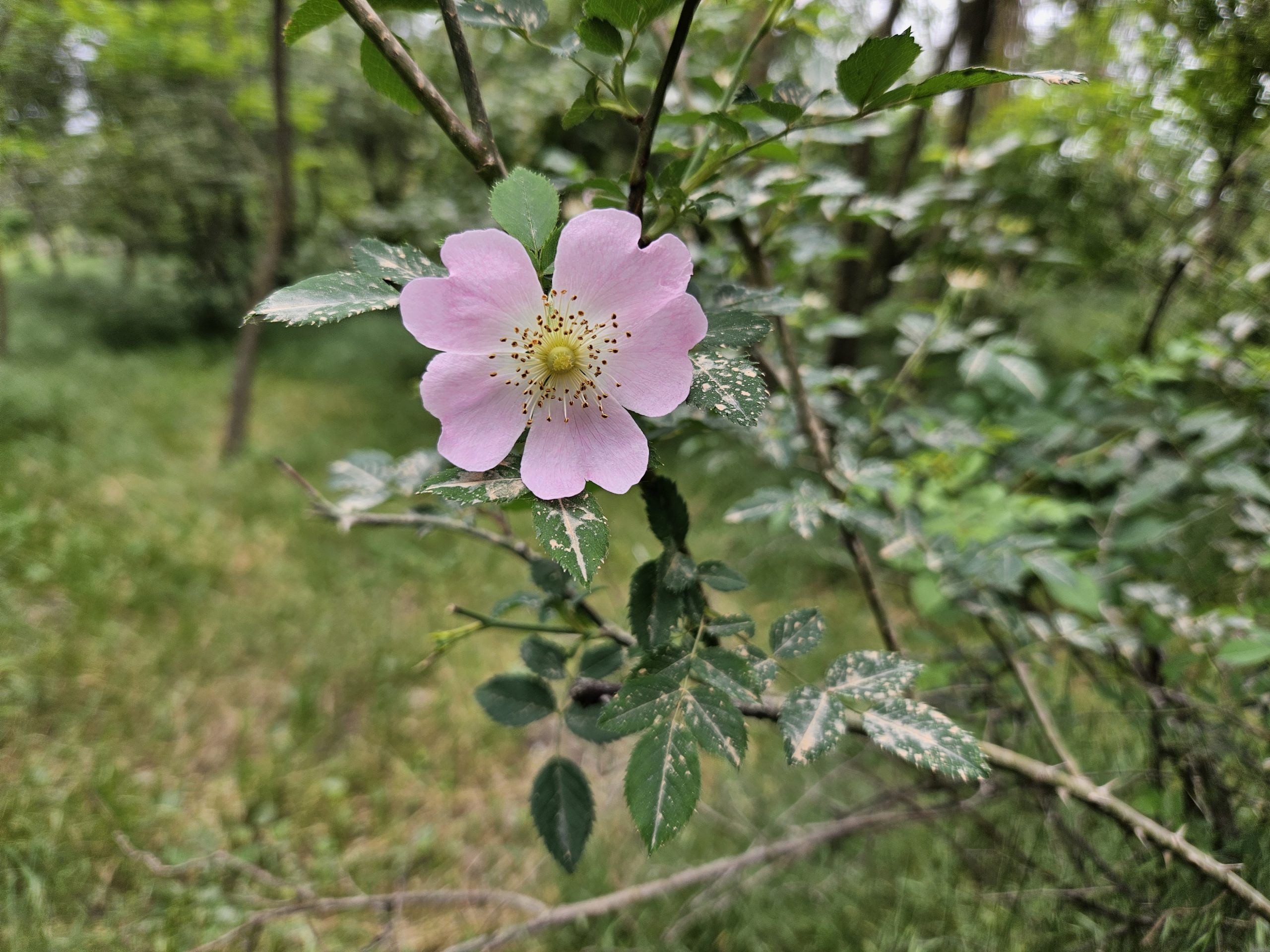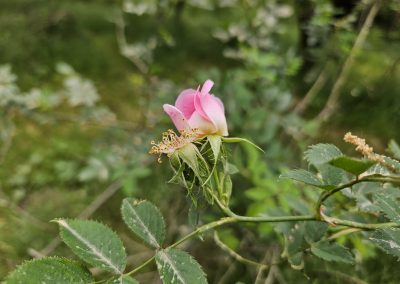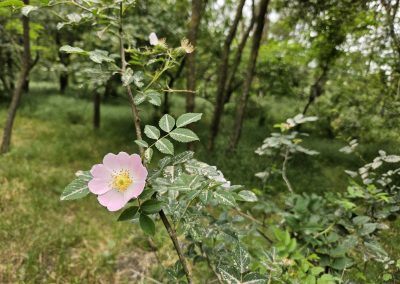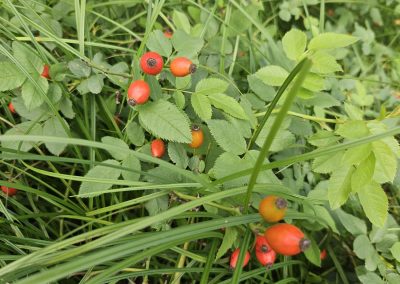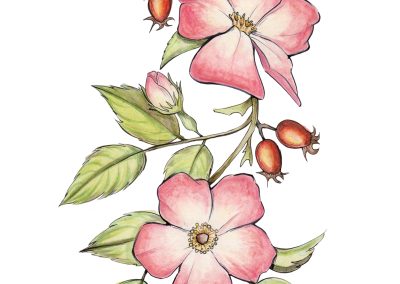Rosa canina
Scientific description
Rosa canina – Spruce / Dog Rose
Division: Angiospermatophyta (Magnoliophyta)
Class: Dicotyledonatae (Magnoliatae)
Subclass: Rosidae
Order: Rosales
Family: Rosaceae
Subfamily: Rosoideae
Origin: Northern hemisphere, continental and subtropical regions
Description:
Thorny shrub 2–5 m high, stiff thorns, slender at base, recurved at tip. Stems elongated, branched, outward curved or pendulous. Leaves pinnately compound, stipules concentric with petiole. Flowers solitary, pinkish-white, fragrant. Receptacle cup-like, calyx 5 sepals (3 pinnately fused, 2 entire), corolla 5 free petals. Androecium numerous stamens, gynoecium numerous free hairy carpels. Fruit an achene enclosed in fleshy receptacle, forming false multiple red fruit, edible.
Propagation: Seeds at physiological maturity, drajons, cuttings, marcottage.
Ecology:
Grows in deciduous forests, rarely coniferous, forest edges, clearings, glades, roadsides. Prefers sunny places, moderate humidity, drought and frost resistant.
Use:
Ornamental in groups or isolated, decorative, rootstock for roses. Pharmaceutical: fruit rich in vitamins, mineral salts, tannin, volatile oils. Recommended in avitaminosis, enterocolitis, peripheral circulation disorders.
Danger:
Vitamin reservoir; in some areas, invasive.
Rosa canina – măceș
Încrengătura: Angiospermatophyta (Magnoliophyta)
Clasa: Dicotyledonatae (Magnoliatae)
Subclasa: Rosidae
Ordinul: Rosales
Familia: Rosaceae
Subfamilia: Rosoideae
Origine: emisfera nordică, regiunile continentale și subtropicale
Descrierea:
Arbust spinos 2–5 m înălțime, ghimpi rigizi, lați la bază, recurbați la vârf. Tulpini alungite, ramificate, recurbate în afară sau pendule. Frunze penat compuse, stipelele concrescute cu pețiolul. Florile solitare, alb-roz, odorante. Receptacul cupă, caliciu 5 sepale (3 penat fidate, 2 întregi), corolă 5 petale libere. Androceul numeroase stamine, gineceul numeroase carpele libere și păroase. Fruct achene în receptacul cărnos, fruct fals multiplu, roșu, comestibil.
Înmulțire: Semințe la maturitatea fiziologică, drajoni, butași, marcotaj.
Ecologia:
Păduri de foioase, rar rășinoase, margini și rărituri, poienițe, drumuri. Preferă locuri însorite, umiditate moderată, rezistă la secetă și ger.
Utilizare:
Ornamental în grupuri sau izolat, portaltoi pentru trandafiri. Farmaceutic: fructe bogate în vitamine, săruri minerale, tanin, uleiuri volatile. Recomandat în avitaminoze, enterocolite, tulburări circulatorii periferice.
Pericol:
Rezervor de vitamine; arbust invaziv în unele zone.
Rosa canina – Κυνόροδο / Αγριοτριανταφυλλιά
Φυλοταξία: Angiospermatophyta (Magnoliophyta)
Κλάση: Dicotyledonatae (Magnoliatae)
Υποκλάση: Rosidae
Τάξη: Rosales
Οικογένεια: Rosaceae
Υποοικογένεια: Rosoideae
Προέλευση: Βόρειο Ημισφαίριο, ηπειρωτικές και υποτροπικές περιοχές
Περιγραφή:
Αγκαθωτός θάμνος 2–5 μ., σκληρά αγκάθια, πλατιά στη βάση, κυρτωμένα στην κορυφή. Βλαστοί επιμήκεις, διακλαδισμένοι, κυρτωμένοι ή κρεμαστοί. Φύλλα πεταλωτά, στέπες συγχωνευμένες με ποδίσκο. Άνθη μοναχικά, λευκο-ροζ, αρωματικά. Υποδοχέας σε σχήμα ποτηριού, κάλυκας 5 φύλλα (3 πεταλωτά, 2 ολόκληρα), κορώνα 5 ελεύθερα πέταλα. Άνδρας πολλοί στήμονες, γυναικείο όργανο πολλές ελεύθερες τριχωτές καρποί. Καρπός: αχένες στο σαρκώδες υποδοχείο, ψευδοκαρπός κόκκινος, βρώσιμος.
Αναπαραγωγή: Σπόροι στη φυσιολογική ωριμότητα, παρακλάδια, μοσχεύματα, καταβολάδες.
Οικολογία:
Φυλλοβόλα δάση, σπάνια κωνοφόρα, περιθώρια, λιβάδια, δρόμοι. Ηλιόλουστα μέρη, μέτρια υγρασία, αντοχή σε ξηρασία και παγετό.
Χρήση:
Διακοσμητικό σε ομάδες ή μεμονωμένο, υποκείμενο για τριαντάφυλλα. Φαρμακευτική αξία: φρούτα πλούσια σε βιταμίνες, ανόργανα άλατα, τανίνες, αιθέρια έλαια. Συνιστάται για υποβιταμίνωση, εντεροκολίτιδα, περιφερειακές διαταραχές.
Κίνδυνος:
Αποθετήριο βιταμινών, σε ορισμένες περιοχές επεμβατικός.
Rosa canina – Églantier
Embranchement: Angiospermatophyta (Magnoliophyta)
Classe: Dicotylédones (Magnoliatae)
Sous-classe: Rosidae
Ordre: Rosales
Famille: Rosaceae
Sous-famille: Rosoideae
Origine: Hémisphère nord, régions continentales et subtropicales
Description:
Arbuste épineux 2–5 m, épines rigides, fines à la base, recourbées au sommet. Tiges allongées, ramifiées, recourbées vers l’extérieur ou pendantes. Feuilles pennées, stipules continues avec pétiole. Fleurs solitaires, rose pâle, parfumées. Réceptacle en coupe, calice 5 sépales (3 fusionnés, 2 entiers), corolle 5 pétales libres. Androcée nombreux étamines, gynécée nombreuses carpelles libres poilus. Fruit: akène dans réceptacle charnu, faux fruit rouge, comestible.
Multiplication: Graines à maturité physiologique, drageons, boutures, marcottage.
Écologie:
Forêts feuillues, rarement conifères, lisières, clairières, bords de route. Préfère ensoleillé, humidité modérée, résistant sécheresse et gel.
Utilisation:
Ornemental en groupes ou isolé, porte-greffe pour rosiers. Intérêt pharmaceutique: fruits riches en vitamines, sels minéraux, tanins, huiles volatiles. Recommandé contre avitaminose, entérocolite, troubles circulatoires périphériques.
Danger:
Réservoir de vitamines; arbuste invasif dans certaines régions.
Creative writing inspired by Rosa canina
Written by Merve Sevdanur Meral
The Rosehip and the Shadow
In the quaint medieval town of Lavenham, lying in the green hills of medieval England, dwelled two companions—Eleanor, a young spirited maiden belonging to the aristocracy, and Ludwig, a poor boy whose family lived deeply in the village soil.
Even though their life seemed divided by birth and rank, fate had planned to join their life on a quiet evening beneath the shadow of the ancient castle walls. When twilight cast the village in its purple hush, Eleanor, worn out by the demands of her noble duty, ran for refuge to the overgrown gardens of the forgotten castle—a site as old as legend and said to be guarded by ancient ghosts of the land.
There, under lavender-scented darkness and bramble-kissed wind, she looked down on a single, isolated rosehip. Away from all other flowers, this one shone softly in the fading light, its scarlet petals kissed with gold, like fire that had been kissed by moonlight. Drawn to it, Eleanor extended a hand to gently run her fingers over its soft edges, unaware of the eyes spying through the hedge on the opposite side.
Ludwig, the silent gardener's boy, had been looking at Eleanor for a long time from a distance. But this flower was no accident. In local tradition, the rosehip was said to be a present from Étaín, the Celtic goddess of love and metamorphosis—a gift that would only reveal itself when passion met destiny. Each night, Ludwig would leave the enchanted rosehip where she would find it, hoping it would speak in words he could not understand.
And it did. With every flower, Eleanor's desire grew—a tender ache in her breast repeating the whispers of the old garden spirits. She began to await the flower's return, fantasizing about some hidden one, someone who knew her soul more intimately than silks and ceremony.
On one moonlit night, not being able to bear his quietness, Ludwig stepped into the light of the garden and spoke. His voice trembled, but his words were sincere: he had placed the rosehips, not out of duty, but out of love. The flower was his heart all along—low-key, wordless, and sincere.
Eleanor's eyes grew wide with wonder. She saw not a peasant in Ludwig, but a soul untroubled by the judgments of the world, his love as immovable as the stars. She recalled a tale her nursemaid used to relate to her—that the rosehip, given honestly and accepted in an open heart, would break spells and call forth old ties.
And so they ran—not foolishly, but fearlessly—through lavender fields and into distant lands, where station counted for little and hearts were clearer than names. With every step, they rewrote the story the world had told them. And when they stood beneath the same stars beneath which Étaín had danced, Eleanor knew: she had not found only love, but a myth in the flesh—a flower born of magic, devotion, and defiance.


